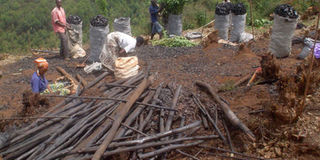Uganda needs alternative energy sources

Burning charcoal in Uganda is a key activity across the country. But it presents grave dangers to both the economy and the environment. FILE PHOTO
Kampala- Goal seven of the UN general assembly on new Sustainable Development Goals (SDGs) adopted in September, requires that countries “ensure access to affordable, reliable, sustainable and modern energy for all” by 2030.
The goal comes at a time when Uganda, like the rest of the developing world, is experiencing rapid urbanisation and a radical shift from wood fuel to charcoal consumption.
Data from ministry of Energy indicates that urban centres consume about1.8 million tonnes of charcoal annually.
This, and the exclusivity of wood fuel use in rural areas, among other reasons, makes Uganda lose more than 92,000 hectares of trees annually with only 7,000 hectares replenished.
If we are to go by a recent 2014 ministry of Energy projections that put the growth of biomass energy demand at a mean annual rate of 50 million tonnes, demand is likely to outstrip supply in the near future, unless quick interventions are made.
The report indicates that biomass energy demands may hit 135 million tonnes up from the current 44 million tonnes by 2040, the country will then run out of energy resources in the next few years.
As of this year, according to ministry of energy commissioner in charge of renewable Energy Godfrey Ndawula, the tree resource stock stands at only 286 million tonnes, which means that the current consumption is likely to grow more because of population pressures. Only 25 million tonnes is available annually for energy, creating an annual deficit of 15 million tonnes.
The sector
Apart from the biomass sector feeding energy needs, an estimated 200,000 people derive incomes from it directly as charcoal burners, according to Mr Ndawula.
“Even 200,000 people are an estimate because the sector is informal but numbers should be much higher. We also estimate dependents to be at one million people,” he says.
The trade in biomass products like charcoal and wood is more profitable to individuals than agriculture and the trade is valued at Shs5.5 trillion annually.
Without wood and charcoal, almost all Ugandans would be unable to cook despite the country increasing its electricity supply of installed generation capacity from 60 megawatts (MW) in 1954 to 682 MW as of 2012.
This is due to high tariffs where a domestic consumer is charged Shs558.4 a unit, a few Ugandans can afford especially, for cooking.
A report by World Wide Fund For Nature (WWF) released last month titled Energy Report for Uganda a 100 per cent Renewable Energy Future by 2050, indicated that the biomass sector will continue to play a critical role in the energy mix of Uganda despite lots of investment in other sources like petroleum and hydro generations.
“Biomass will remain a cornerstone of Ugandan energy supply for some time. Key to modernisation is the transition by both industry and households to use of efficiently produced biomass fuels and efficiently cooking and conversion devices.
“There is need to modernise the biomass sector so that use of firewood, charcoal and agricultural by-products is done efficiently and biomass is managed holistically,” reads part of the report.
Endowed
Mr Ndawula says Uganda is endowed with a favorable environment that enables growth of natural energy resources and to salvage the demand with the ministry starting a pilot project that will see 18 million trees, mainly for charcoal production grown in districts of Kiboga, Nakaseke, and Kiryandongo.
“We have so far planted one million in those districts because we cannot live without biomass. The sector is very important but we encourage private people to plant more trees and use improved stoves in their homes,” Mr Ndawula says.
Also, he says, the ministry will pilot a charcoal burning technique that improves carbonisation of trees. These technologies will include batch-type retorts where wood is carbonised by an external source of heat and metal kilns equipped with vapour incinerators to turn trees into charcoal.
Developing alternatives
The Ministry of Energy and German Federal Ministry for Economic Cooperation and Development are currently implementing a Renewable Energy and Energy Efficiency Programme according to the former’s website, with more than 21,000 people, 200 social institutions and about 300 small and medium-sized businesses now benefiting from solar and grid connections, while more than 200,000 people have gained from improved cooking stoves.
Mr Ndawula says there are abundant business opportunities in the sector that are yet to be tapped into.
For example, he says, majority of agro residues from rice husks, sugarcane, maize, matooke, among others, are wasted yet they can be used to make briquettes that can last for a long hours on cooking stoves.
Also, there has been low adaption of improved cooking stoves that can halve the amount of charcoal used by conventional stove to cook.
How sectors use wood/ charcoal
One kilogramme of tea requires 1.5kg of wood.
One other heavy wood consumer is lime production. Although they are mainly on small scale, the sector consumes 270,000 tonnes of wood and 75 tonnes of charcoal annually. This means that every tonne of lime production requires 1.5 tonnes of wood.
The tobacco industry estimated at an average production of 25,000 tonnes annually, consume 200,000 tonnes of wood.
The report further notes that sugar jaggeries consume 500 tonnes of wood and 2,000 tonnes of bagasse annually.
The 40,000 tonnes of oil produced annually by local oil companies require 17,000 tonnes of agriculture waste and 75,000 tonnes of wood.
Another 224,000 tonnes of wood is lost annually to smoke 20,000 tonnes of fish.
The wood consumed in confectionery industry is estimated at 313,000 tonnes. Another 200,000 and 50,000 tonnes of wood and charcoal respectively are consumed by 35,000 hotels. With an estimate of 37,000 inmates annually, prisons consume 5,435 tonnes of wood. Hospitals consume 1,900 tonnes of wood and educational institutions are estimated to use 1.7 million tonnes of wood annually.




